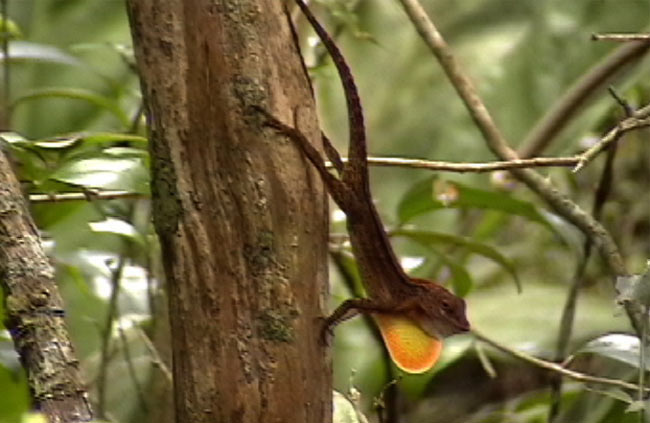Video Captures Hyperactive Lizards Defending Turf

Like dancers in a crowded nightclub, some lizards ramp up their body movements to be seen above the background chaos in order to better defend their turf.
Scientists have shown how animal species, such as birds, monkeys and frogs, alter their acoustic signals to stand out against a noisy backdrop.
A new study broadens this phenomenon to organisms that communicate visually, said lead scientist Terry Ord of the University of California-Davis.
To advertise ownership of territory, a male anole lizard bobs its head, extends a colorful throat pouch and sweeps its tail up and down in an arc. The lizard can spot a rival lizard up to 80 feet away.
- Video 1: Lethargic Lizard : The lizards use subtle visual displays to communicate with one another when their forest background is relatively still.
The lizards’ signals need to be prominent enough for a rival to see, but not showy enough to draw attention from a passing predator. Adding another nuance, their forest home can compete with the displays and even visually drown them out on a particularly windy or rainy day.
"They have to have a strategy to get their message across," Ord said.
Ord and his colleagues took digital video of two species of anole lizards [image], Anolis cristatellus and Anolis gundlachi, in the Caribbean National Forest in Puerto Rico. They recorded each lizard for an average of 28 minutes. Later, the scientists calculated the maximum speed for each video frame to come up with average head-bob and background-vegetation speeds.
Get the world’s most fascinating discoveries delivered straight to your inbox.
- Video 2 - Lively Lizard:
Males stuck amid a bustling background bobbed and arched in hyperactive mode, while on a calm day the displays were less active. The males actually adjusted, in real-time, the speed of their body movements based on the level of background visual “noise.”
Ord hopes to trace the evolution of lizard signals by studying a variety of anole lizard species living on islands of the Caribbean. While the different species are separated by up to 30 million years of evolution, they live in similar environments with the same natural obstacles to communication.
The research is detailed in the current online edition of the Proceedings of the Royal Society B.
- Vote Now: The Ugliest Animals
- Images: Snakes, Frogs and Lizards
- Colorful Strategy: Why Lizard Tails Change with Age
- Top 10 Animal Senses Humans Don’t Have
Jeanna Bryner is managing editor of Scientific American. Previously she was editor in chief of Live Science and, prior to that, an editor at Scholastic's Science World magazine. Bryner has an English degree from Salisbury University, a master's degree in biogeochemistry and environmental sciences from the University of Maryland and a graduate science journalism degree from New York University. She has worked as a biologist in Florida, where she monitored wetlands and did field surveys for endangered species, including the gorgeous Florida Scrub Jay. She also received an ocean sciences journalism fellowship from the Woods Hole Oceanographic Institution. She is a firm believer that science is for everyone and that just about everything can be viewed through the lens of science.


